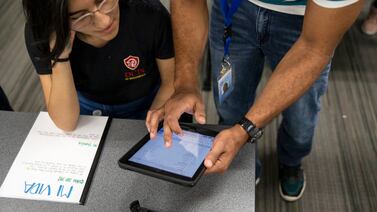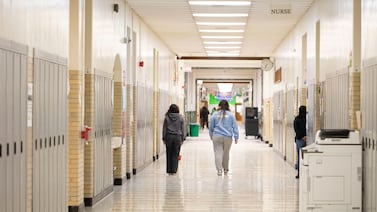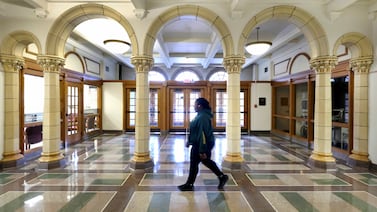Sign up for Chalkbeat’s free weekly newsletter to keep up with how education is changing across the U.S.
COVID disruptions continue to cast a long shadow over student learning, with middle school students in particular suffering the cumulative effects of years of missed lessons, new research shows.
The analysis from the testing group NWEA released Tuesday estimates that eighth graders would need an additional nine months of schooling — an entire school year, essentially — to do as well as their counterparts before the pandemic. Third graders, meanwhile, would need a little more than two months of extra schooling to match their counterparts, according to results from the group’s MAP Growth tests that it administers several times a year.
Across grades and subjects, students continue to perform worse on these tests than similar students did before COVID. And after starting out behind in the fall, they made less progress during the school year than their pre-COVID counterparts, as measured by spring test results. That gap widened an average of 36% in reading and 18% in math over the course of the school year, NWEA found.
Overall, the findings are less optimistic than other recent analyses that found students making above-average growth, based on state standardized test scores and the National Assessment of Education Progress or NAEP. Results from the NAEP administered earlier this year aren’t available yet.
The analysis underscores that pandemic-era strategies like additional instructional time, tutoring, and summer school must continue, even after the expiration of federal COVID relief, if students are to continue recovering academically, said report author Karyn Lewis, director of NWEA’s Center for School and Student Progress.
“What I really want people to take away from this is we can’t turn away, we can’t take our foot off the gas, as tempting as it may be,” Lewis said.
Related: Schools have struggled to add learning time after COVID. Here’s how one district did it.
The most recent analysis is based on the reading and math test scores of 7.7 million students in grades 3-8 during the 2023-24 school year in more than 22,000 public schools. NWEA compared these test results with a similar cohort of 11 million students who took the tests between fall 2016 and spring 2019.
NWEA also found stagnant student growth during the 2022-23 school year, even as some state standardized tests started showing signs of recovery.
Lewis said it’s not that one test or analysis is more accurate than another. Different findings could be related to differences in what the assessments measure, Lewis said. State standardized tests are summative assessments that measure student performance against grade-level state standards late in the school year. MAP Growth assessments are interim assessments that pick up more nuances about which skills students do and don’t have.
MAP assessments can also show the progress of students performing well above or far below state standards — and in both cases, they made less progress on average in the most recent school year than their counterparts before the pandemic.
Lewis said she would rather err on the side of finding less recovery, than accidentally paint too rosy a picture. Even studies that found more student growth also found that inequality is growing, and students are still behind pre-pandemic performance. Without ongoing intervention, Lewis said, those inequalities are likely to worsen.
The findings that middle schoolers are more behind than younger learners is particularly concerning, Lewis said, because they tend to learn at a slower pace than younger students. They also have less time left in the school system to potentially benefit from interventions.
“We really want to be paying attention to those middle schoolers who have the furthest to go and the least amount of time in the school system,” she said. “That’s a really alarming one-two punch.”
Last year’s eighth graders were in fourth grade in March 2020 and experienced major disruptions from remote learning and quarantines through fifth and sixth grade. Now they’re heading to high school.
Middle schoolers who might be missing math skills will find it harder to do more advanced work, Lewis said. They may also need different reading instruction strategies than younger students.
Related: Many schools want to keep tutoring going when COVID money is gone. How will they pay for it?
But even students who were not even in school when the pandemic started — children who were in first and second grade during the most recent school year — are behind their pre-pandemic counterparts, NWEA found. That echoes recent findings from Curriculum Associates, which reported that even students who were toddlers during the height of the pandemic suffered academic setbacks.
It’s not entirely clear why, but many students missed out on preschool and kindergarten, especially in states where kindergarten isn’t mandatory. Children may also have been affected by their parents’ stress and economic setbacks.
NWEA found that Hispanic students in particular suffered relatively large academic impacts and likely need more support to catch up. The average Hispanic elementary student would need an additional month of extra instruction to catch up, compared with the average white student. The average Hispanic middle school student would need an additional two months.
Hispanic families suffered high rates of job losses and economic insecurity alongside high rates of death and serious illness during the pandemic. Hispanic parents also held many “essential” jobs that meant they couldn’t stay home and support remote learning.
Other research suggests community factors such as COVID and employment rates may have played a role in learning loss.
Erica Meltzer is Chalkbeat’s national editor based in Colorado. Contact Erica at emeltzer@chalkbeat.org.





